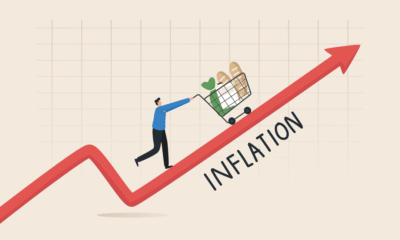Finance
Credit Card Debt in the US Hits Record High – What You Should Know

Understanding the Current State of Credit Card Debt
As of October 2023, the credit card debt in the United States has reached an unprecedented level, with the total outstanding balances soaring past $1 trillion. Recent reports indicate that this surge represents a significant increase, alongside a trend that reflects changing consumer behaviors and economic conditions. The average American household now carries an average balance of approximately $8,000 on their credit cards, marking a staggering rise compared to previous years. This increase can be attributed to various factors, including inflationary pressures and heightened consumer spending amidst economic recovery efforts following the pandemic.
The ongoing impacts of inflation have forced consumers to rely more on credit cards for everyday purchases. With essentials becoming more expensive, many individuals are struggling to maintain their purchasing power. This trend indicates a shift in financial management, where credit is increasingly viewed as a necessity rather than an option. Furthermore, the ease of obtaining credit cards, coupled with the attractive promotional offers, has encouraged more consumers to accumulate debt without fully considering the long-term implications. Statistics show that more than 60% of cardholders carry a balance month to month, underscoring a widespread reliance on credit for managing financial obligations.
When comparing current statistics to previous years, the growth trajectory of credit card debt highlights an alarming trend. For instance, in early 2020, the total credit card debt stood approximately $900 billion, but since then, the increase has been swift and substantial. This ongoing escalation poses potential risks for both consumers and the broader economy, prompting discussions about responsible borrowing and financial literacy. It is crucial for consumers to navigate this complex landscape thoughtfully, using credit judiciously to avoid further entrenching themselves in debt. Understanding this current state of credit card debt is vital for informed decision-making in personal finance.
Factors Contributing to Rising Credit Card Debt
The current landscape of credit card debt in the United States is shaped by multiple interconnected factors. One of the most significant drivers is the persistent inflation that has affected various sectors, including food, housing, and energy costs. As consumers navigate these economic challenges, many are resorting to credit cards to maintain their standard of living, leading to an increase in outstanding balances. With prices rising steadily, individuals are finding it increasingly difficult to meet their day-to-day expenses without relying on credit, contributing to the overall growth in credit card debt.
Additionally, the rising costs of living present another crucial aspect. Many households are grappling with stagnant wages that do not keep pace with the escalating expenses associated with basic necessities. This incongruity forces some consumers to increasingly depend on credit to bridge the gap between their income and expenditures. As a result, the utilization rates of credit cards have surged, often exceeding the recommended levels, which can lead to further financial complications.
The COVID-19 pandemic has also had a profound effect on consumer behavior and personal finances. The economic fallout from the pandemic triggered job losses and reduced incomes for numerous families, and while some may have utilized government relief measures, the recovery has been uneven. Many individuals turned to credit cards to cover immediate costs during periods of financial instability. Consequently, this shift in consumer spending habits has created a landscape where credit card debt accumulates as a necessary financial tool for survival rather than as a means of managing discretionary purchases. As these factors intertwine, they paint a comprehensive picture of the root causes behind the escalating credit card debt crisis in the United States.
The Impact of High Credit Card Debt on Consumers
High credit card debt can significantly detriment individuals’ personal financial health, leading to a variety of implications that reach far beyond mere monetary concerns. As consumers accumulate debt, they often experience heightened stress levels. The constant worry about meeting minimum payments can negatively affect mental well-being, resulting in anxiety and sleepless nights. This stress can also manifest in physical health issues, further complicating the individual’s financial situation.
In addition to mental health challenges, high credit card debt can considerably impact credit scores. These scores are critical in determining a person’s eligibility for loans, mortgages, and other forms of credit. A growing debt-to-income ratio caused by accumulating credit card balances can lead to reduced credit scores. This decline can make it more difficult for consumers to secure financing at favorable interest rates, ultimately restricting their options for significant purchases such as homes or vehicles.
The implications of high credit card debt extend to essential life choices as well. Many individuals find that their financial obligations limit their ability to pursue higher education or career advancement, particularly if student loans are also part of the mix. Furthermore, those laden with debt often postpone significant milestones like buying a home or starting a family due to financial constraints. Retirement savings also take a hit as consumers prioritize managing immediate debt over planning for the future. This decision can lead to long-term repercussions, including reduced quality of life during retirement years.
Ultimately, the cycle of high credit card debt influences every aspect of an individual’s financial landscape. It affects not only present-day decisions but also has lasting implications for future aspirations and overall quality of life. As the trend of increasing debt persists, understanding these impacts becomes crucial for consumers striving for financial stability.
Strategies for Managing and Reducing Credit Card Debt
Managing and reducing credit card debt is imperative for maintaining financial health, especially given the record high levels of debt reported recently in the United States. The first step towards tackling credit card debt is creating a comprehensive budget. This budget should account for all sources of income and expenditures, allowing individuals to gain insight into their spending habits. By identifying non-essential expenses, individuals can allocate more funds toward paying down their credit card balances while still covering their essential needs.
Once a budget is established, the next strategy involves prioritizing debt payments. Individuals should focus on tackling debts with the highest interest rates first, often referred to as the avalanche method. Conversely, those who prefer quicker wins may opt for the snowball method, which entails paying off the smallest debts first to build momentum. Whichever method is chosen, consistency in payments is critical for reducing overall credit card debt.
Another effective approach is debt consolidation. This process involves combining multiple credit card debts into a single loan or credit line, ideally with a lower interest rate. Consolidation simplifies payments by reducing the number of monthly obligations, and it can also lower interest costs, making it easier to manage financial commitments. Individuals may explore options such as personal loans or balance transfer credit cards for this purpose.
In addition to these strategies, seeking professional advice from financial counselors or utilizing online resources can provide personalized assistance tailored to individual circumstances. It is vital to remain proactive in addressing credit card debt, ensuring that individuals regain control over their financial situations and mitigate the risks associated with prolonged indebtedness.
When to Seek Help for Credit Card Debt
Credit card debt can become overwhelming, especially as interest accumulates and monthly payments increase. Recognizing the signs that you should seek help is crucial to regaining financial stability. One of the most significant indicators that assistance is necessary is when monthly credit card payments become unmanageable. If you find yourself consistently making late payments or paying only the minimum amount due, it may be time to consider consulting a financial advisor or a credit counselor.
Another warning sign is if you are relying on credit cards to cover essential expenses, such as groceries or utilities. This behavior can indicate a deeper financial issue that requires intervention. Seeking help from professional sources like credit counseling services or debt relief agencies can provide valuable insights and options tailored to your situation. These professionals specialize in helping individuals navigate the complexities of credit card debt and can assist in creating a structured repayment plan that aligns with your financial capabilities.
Moreover, if you have accumulated multiple credit cards with outstanding balances, it may be beneficial to explore consolidation options. Credit counselors can explain various consolidation methods, including balance transfer cards or personal loans, which can simplify your financial commitments and potentially lower interest rates. The goal of seeking help should always focus on a path to financial health, and professionals in the field can guide you through the process with expertise.
Ultimately, it’s essential to act promptly at the first signs of financial distress. Ignoring credit card debt usually leads to more significant complications, making recovery increasingly difficult. By acknowledging the need for help, you can take proactive steps to improve your financial situation and regain control of your finances.
The Role of Credit Card Companies in the Debt Cycle
The increasing levels of credit card debt in the United States can be linked, in part, to the practices employed by credit card companies. These companies play a significant role in shaping consumer behavior and contributing to the accumulation of debt. One of the primary ways credit card companies induce spending is through enticing promotional offers. Many companies entice consumers with attractive introductory offers, such as zero percent interest for an initial period or significant cash-back rewards. While these offers can be appealing, they may lead consumers to overspend or carry a balance beyond their means, ultimately contributing to a cycle of debt.
Interest rates further complicate the situation. Many credit cards impose high annual percentage rates (APRs), which can escalate quickly if balances are not paid in full. When consumers rely on credit cards for everyday purchases or emergencies, the inability to make timely payments results in accruing substantial interest charges. This increase in financial burden can perpetuate a cycle where consumers are forced to take on additional debt to manage existing balances, leading to a precarious financial situation.
Regulatory measures exist to protect consumers from predatory lending practices, but there are ongoing debates about their effectiveness. The Truth in Lending Act mandates that card issuers disclose specific terms and fees clearly; however, many consumers find this information complex and difficult to understand. Suggestions for further regulatory changes aim to increase transparency regarding interest rates and fees associated with credit cards. Strengthening consumer education and ensuring clarity in promotional practices may help mitigate some of the debt cycle attributed to credit card companies. Understanding these dynamics is critical for consumers, as it emphasizes the importance of making informed financial decisions to avoid falling into debt traps created by credit card practices.
Alternatives to Using Credit Cards
As credit card debt reaches unprecedented levels in the United States, consumers are increasingly seeking alternatives to traditional credit card usage. These alternatives can help mitigate the risk of accruing excessive debt while still providing flexible payment options for everyday purchases.
One popular alternative is the debit card. Unlike credit cards, which allow users to borrow money up to a certain limit, debit cards draw directly from a consumer’s bank account, providing a clear limit based on available funds. This can enhance budgeting skills, as users are less likely to overspend. However, debit cards may lack some of the protections that credit cards offer against fraud, making it essential for consumers to remain vigilant about security.
Cash is another option that many individuals overlook. Using cash for transactions can significantly limit spending since consumers can only spend what they physically possess. This method can promote responsible financial habits and keeps one from the temptation to overspend that often accompanies electronic payments. Nevertheless, cash transactions can be impractical for online purchases and may lack the convenience of electronic payment methods.
Buy-now-pay-later (BNPL) services have gained popularity as a modern alternative. These services allow consumers to make purchases and pay for them over time in installments. While BNPL can provide a flexible payment solution, consumers should be cautious, as missing payments can lead to additional fees and a negative impact on one’s credit score.
Ultimately, the choice of payment methods depends on individual preferences and circumstances. Each alternative has its pros and cons, and consumers should weigh these factors carefully to make informed financial decisions that help them avoid the pitfalls of credit card debt.
Future Trends: What’s Next for Credit Card Debt?
The mounting credit card debt in the United States has prompted a reevaluation of consumer behavior, industry practices, and regulatory frameworks. As economic indicators fluctuate, various trends may emerge that significantly shape the landscape of credit card usage and debt levels in the coming years.
Current inflation rates, interest rates, and employment figures provide critical insights into potential future trends. Many consumers are facing increased financial pressure, which could lead to a more cautious approach regarding credit card utilization. Surging costs of living may compel individuals to rely on credit cards more than in the past, potentially contributing to higher debt levels. Conversely, as consumers become aware of their financial circumstances, there may be a trend toward reducing dependence on credit, emphasizing savings over spending.
Furthermore, technological advancements are likely to play an essential role in the evolution of credit card debt. Fintech innovations and improvements in personal finance management tools may empower consumers to monitor their spending more effectively and make informed payments. The use of budgeting apps and automated payment systems could reduce instances of missed payments, subsequently influencing overall debt levels.
Regulatory changes could also impact credit card debt trends. Ongoing discussions surrounding stricter lending practices or more transparent financial products may lead to a shift in how credit card companies operate. Increased scrutiny on credit card fees and interest rates may empower consumers to make better financial choices and reduce the propensity for accumulating unmanageable debt.
In conclusion, the future of credit card debt in the U.S. is likely to be influenced by various factors, including economic conditions, consumer behavior, and regulatory responses. Staying informed and adjusting spending habits accordingly will be crucial for navigating this dynamic landscape.
Conclusion: Taking Charge of Your Financial Future
As we have explored, credit card debt in the United States has reached alarming levels, prompting a pressing need for individuals to understand the implications of such debt on their financial health. The statistics indicate that many consumers are grappling with increasing balances, high-interest rates, and the strain of minimum payments that hardly touch the principal amount owed. This scenario underscores the critical importance of awareness and proactive management of personal finances.
It is essential for consumers to be informed about their credit card usage and to recognize the signs of excess debt accumulation. Developing a budget that encompasses all expenditures, including credit payments, can be a valuable first step in reclaiming financial control. Moreover, consumers should consider strategies such as debt consolidation, negotiating lower interest rates, or even seeking the assistance of financial advisors to create a manageable repayment plan. Each of these approaches can significantly aid those struggling with credit card debt.
Additionally, it is crucial to cultivate responsible credit habits moving forward. This entails using credit cards judiciously—ensuring that purchases made on credit are affordable and that the cardholder can meet payment obligations promptly. By making informed choices about credit utilization, individuals can mitigate the risks associated with carrying balances, thus avoiding the cycle of debt that is so common in today’s society.
In light of the current credit card debt landscape, taking charge of one’s financial future is not merely advisable, but an absolute necessity. Individuals who take action—whether through enhanced budgeting, seeking professional advice, or understanding their credit options—will set themselves on a path towards improved financial well-being. Ultimately, awareness and focused efforts are keys to turning the tide on credit card debt and securing a more stable financial future.
Investing
Global Investor Outflows from U.S. Stocks & Dollar

In a shift that is sending ripples across financial markets, institutional investors around the world are pulling back from U.S. equities and reducing exposure to the U.S. dollar, signaling a significant change in sentiment toward American assets. According to the latest Bank of America Global Fund Manager Survey, global investors are now the most underweight on U.S. stocks in more than two decades, with the dollar facing similar skepticism as a long-term safe-haven asset. This transition is being fueled by multiple converging factors, including geopolitical instability, growing U.S. fiscal deficits, trade tensions, and an increasingly favorable investment climate in Europe and select emerging markets. For investors, economists, and policymakers alike, this trend represents a rebalancing of global capital flows that could reshape market dynamics in the months ahead.
Investor Sentiment Toward U.S. Markets Hits Multi-Year Lows
The Bank of America survey, considered a key barometer of global institutional sentiment, reveals that fund managers have turned heavily underweight on U.S. stocks and the dollar, preferring instead to rotate their portfolios into European and Asian equities. The survey showed that 36% of participants are now net underweight U.S. equities—the highest level since 2003. At the same time, positioning on the dollar turned net negative for the first time in over five years, with investors citing mounting fiscal concerns, valuation extremes, and weakening macroeconomic indicators.
The U.S. equity market, especially the tech-heavy NASDAQ, has experienced an extraordinary bull run over the last several years. But now, investors are questioning the sustainability of elevated valuations, particularly as economic growth slows, earnings forecasts are revised downward, and inflation remains persistently above target. Many portfolio managers believe the best returns may no longer be found in U.S. assets alone.
Rising U.S. Debt and Fiscal Deficits Raise Red Flags
A key driver of investor caution is the ballooning U.S. fiscal deficit. The Congressional Budget Office (CBO) projects that the U.S. federal deficit will reach over $1.8 trillion this year, driven by increased government spending, rising interest costs, and lower-than-expected tax revenues. The national debt is now projected to exceed 125% of GDP by 2030, raising serious questions about long-term fiscal sustainability.
Investors fear that soaring U.S. debt levels could lead to a loss of confidence in Treasury securities, pushing yields higher and triggering volatility in global credit markets. This concern is magnified by the growing political polarization in Washington, which has led to repeated debt ceiling standoffs and policy gridlock. As a result, some asset managers are choosing to diversify their bond portfolios with sovereign debt from countries like Germany, Canada, and Australia—nations viewed as having stronger fiscal discipline.
Geopolitical Tensions Erode Dollar Safe-Haven Appeal
The traditional role of the U.S. dollar as a global safe-haven currency is also being called into question. With the U.S. now embroiled in rising geopolitical conflicts, including its military engagement in the Middle East and an escalating trade war with China, the perception of the dollar as a “neutral” or stable currency is beginning to fade. Several countries, particularly in the Global South, have voiced frustration over the dominance of the dollar in international trade, and some have even accelerated efforts to settle trade in alternative currencies such as the euro, yuan, or local currency blocs.
In response, central banks in emerging markets are reducing their U.S. dollar reserves and increasing holdings in gold and non-dollar currencies. This trend, while gradual, is gaining momentum and contributing to the dollar’s underperformance against a basket of global currencies. The U.S. dollar index (DXY) has declined by nearly 6% year-to-date, reflecting both diminished investor confidence and a broader reconfiguration of reserve management strategies.
Attractive Valuations Abroad Drive Capital Outflows
While risks in the U.S. are mounting, attractive investment opportunities abroad are also contributing to the outflow of capital from American markets. European equities, particularly in sectors like green energy, luxury goods, and financial services, are seeing renewed interest thanks to relatively low valuations and improving macroeconomic stability. The recent ECB rate cuts and Eurobond discussions have added to optimism about the region’s fiscal and financial integration.
In Asia, countries like India, Indonesia, and Vietnam are emerging as new hotspots for foreign direct investment and equity inflows. These economies offer robust growth prospects, younger demographics, and increasingly tech-driven industries. Additionally, Japan’s bond market is seeing increased institutional buying, as long-term yields rise in response to the Bank of Japan’s policy changes.
This global diversification strategy is not just about seeking higher returns—it’s also about managing risk. Investors are increasingly looking to balance their portfolios geographically, reducing dependence on any single region and hedging against macroeconomic shocks that may be specific to the U.S.
Currency Hedging and Diversification as Defensive Strategies
In response to the dollar’s volatility, many fund managers are now engaging in currency hedging strategies to protect their portfolios. Currency ETFs, options, and forward contracts are being used to minimize the downside risk of a weakening dollar. At the same time, global investment funds are ramping up their exposure to non-dollar-denominated assets, including eurozone corporate bonds, emerging market debt, and local-currency sovereign issues.
Moreover, ESG and green bond markets in Europe and Asia are attracting capital due to their alignment with global sustainability goals. These instruments not only offer diversification but also align with broader institutional mandates on responsible investing.
Implications for U.S. Markets and Monetary Policy
The capital flight from U.S. assets could have significant implications for American markets. A persistent decline in foreign demand for U.S. Treasuries may force the Federal Reserve to intervene more frequently in the bond market to maintain liquidity and control yields. At the same time, a weaker dollar could contribute to imported inflation, complicating the Fed’s efforts to bring core inflation back within its target range.
On the equities side, if investor outflows persist, U.S. companies may face higher capital costs and declining valuations, particularly in sectors that rely heavily on foreign investment or exports. Domestic pension funds and institutional investors may need to fill the gap left by global investors, which could further alter asset allocation strategies and influence corporate financing decisions.
A New Era of Global Capital Rotation
The growing shift away from U.S. stocks and the dollar signals the beginning of a new era in global investing, one defined by diversification, geopolitical hedging, and currency rebalancing. While the U.S. remains a central player in global finance, the days of unquestioned dominance are beginning to fade, as investors embrace a more nuanced and distributed view of risk and opportunity.
For market participants, staying agile in this environment means tracking global fund flows, monitoring geopolitical developments, and reassessing the traditional U.S.-centric portfolio model. As capital continues to flow into European and Asian markets, the future of global finance is being rewritten—and those who adapt early may find themselves ahead of the curve.
Finance and Economy
France Pushes Eurozone Toward Joint Eurobond Issuance

In a bold move that could redefine the financial architecture of the European Union, France has renewed its push for the issuance of joint eurozone debt instruments – commonly referred to as Eurobonds – as a way to strengthen the euro on the global stage. As the EU prepares for its upcoming summit on June 26-27, the proposal is once again stirring heated debate among member nations. French officials argue that a shared debt mechanism is essential not only for financial resilience but also for elevating the euro’s standing as a credible alternative to the U.S. dollar. While the idea garners support from key institutions like the IMF and the ECB, resistance from fiscally conservative member states continues to block consensus. This article explores the implications of France’s proposal, the potential benefits and challenges of Eurobond issuance, and the evolving role of the euro in a multipolar financial world.
France’s Strategic Case for Eurobonds
French President Emmanuel Macron and Finance Minister Bruno Le Maire have long been advocates for deeper EU financial integration. According to them, Eurobonds would represent a tangible step toward fiscal solidarity and monetary cohesion, allowing member nations to borrow at collectively favorable rates while demonstrating political unity. The latest push comes at a time when the European economy is facing several headwinds: slowing growth, fragmented recovery across member states, and heightened global financial volatility triggered by geopolitical conflicts and energy insecurity. Macron has reiterated that a common debt tool is essential for financing major EU-wide projects such as green energy transition, digital infrastructure, and military defense.
From a strategic standpoint, France views Eurobonds as more than just a financial mechanism – they are a symbol of EU credibility and resilience. By pooling risk and aligning borrowing capacity, the eurozone could present a united front in capital markets, reducing the vulnerability of weaker economies and improving the euro’s attractiveness to foreign investors.
The Euro’s Current Global Standing and Its Challenges
Despite being the world’s second most-used currency, the euro still lags far behind the U.S. dollar in terms of global reserve share, trade settlement, and safe-haven preference. Analysts point out that one of the primary reasons for this is the fragmented nature of the eurozone bond market. Each country issues its own sovereign debt, leading to a lack of a single, risk-free eurozone bond benchmark – unlike U.S. Treasuries, which offer deep liquidity and low risk.
France’s proposal seeks to address this imbalance. A unified Eurobond market could create a highly liquid, stable, and scalable financial product that would attract central banks, pension funds, and sovereign wealth investors. Over time, this could shift more global reserves into euros, boosting the currency’s influence in global trade and finance.
Institutional Support: IMF, ECB, and Market Participants
Key international organizations have thrown their weight behind the idea. The International Monetary Fund (IMF) has suggested that Eurobonds could enhance the EU’s fiscal capacity and crisis response agility. Meanwhile, European Central Bank (ECB) officials, including President Christine Lagarde, have hinted that deeper fiscal integration is necessary for the euro to realize its full potential.
Financial market participants have also shown interest. Asset managers argue that Eurobonds could become a cornerstone of fixed-income portfolios, particularly for investors looking to diversify away from dollar-denominated assets. Some analysts compare the opportunity to the creation of the U.S. Treasury market in the post-war era, which laid the groundwork for the dollar’s global dominance.
Opposition from the Frugal Four and Risk-Sharing Concerns
Despite France’s enthusiasm and institutional support, significant opposition persists from fiscally conservative EU nations, notably Germany, Austria, the Netherlands, and Finland—often dubbed the “Frugal Four.” These countries argue that shared debt would penalize responsible fiscal behavior and open the door to moral hazard, where weaker economies might overborrow under the protection of joint guarantees.
German officials have also cited constitutional constraints and public opposition to any perceived “debt mutualization.” Instead, they advocate for reforms at the national level, more stringent budget controls, and the use of existing mechanisms like the European Stability Mechanism (ESM) for crisis funding.
This divide continues to stall formal negotiations. At the heart of the debate is the question of trust and fiscal governance, as many northern states remain skeptical about the long-term commitment of their southern counterparts to austerity and budget discipline.
Implications for Financial Markets and Investors
If approved, Eurobonds would be a game-changer for European capital markets. They would offer a new safe asset class, potentially rivaling U.S. Treasuries in size and reliability over the long term. For the European banking system, Eurobonds could provide high-quality collateral and improve liquidity conditions, especially for cross-border lending.
Investors are closely monitoring the situation. If the EU takes concrete steps toward joint bond issuance, bond yields across peripheral economies like Italy, Spain, and Greece could compress further, as risk premia shrink in anticipation of shared guarantees. Simultaneously, euro-denominated assets may see a surge in foreign inflows, especially from central banks seeking to rebalance reserve portfolios.
Strengthening the Euro’s Role in a Multipolar World
The geopolitical landscape is increasingly defined by multipolarity, with China, Russia, and the U.S. competing for influence in trade, finance, and security. In this context, the eurozone faces a historic opportunity to carve out a more assertive role. Strengthening the euro through fiscal and capital market integration is seen as essential to counterbalance the dollar’s dominance and reduce reliance on U.S.-led financial infrastructure.
Eurobonds could serve as a financial pillar in this transition. As global investors seek alternatives in a fragmented world economy, the euro’s rise as a stable, investable, and liquid currency backed by joint instruments could bolster its credibility and utility.
A Defining Moment for European Unity
France’s push for Eurobonds is more than just a fiscal proposal – it is a call for political and financial unity in a time of global uncertainty. While the road to consensus is steep, the growing support from institutions, investors, and southern EU members suggests that momentum is building. The upcoming EU summit will be a crucial test of the bloc’s ability to move beyond national interests and toward a shared financial future.
If successful, Eurobond issuance could redefine the eurozone’s role in the global economy, offering new tools for crisis response, economic development, and financial competitiveness. For investors and policymakers alike, this moment marks a critical juncture – either Europe seizes the opportunity to lead, or it risks remaining a secondary player in a rapidly evolving financial world.
Finance and Economy
Oil Price Spike as Middle East Conflict Deepens: A Global Market Wake-Up Call

The financial world is once again on high alert as escalating tensions in the Middle East have triggered a sharp surge in global oil prices, sending shockwaves through equity, commodity, and currency markets alike. With the U.S. reportedly striking Iran’s nuclear sites, Brent crude surged over 18%, nearing $80 per barrel in a matter of hours. The sudden volatility reignited fears of a potential $100 oil scenario, reminiscent of past geopolitical flashpoints that deeply impacted global supply chains, inflation expectations, and central bank policy stances. This article delves into the causes, consequences, and global financial implications of this emerging crisis.
The Trigger: U.S. Strikes on Iran’s Nuclear Infrastructure
On June 21, 2025, international news outlets confirmed that U.S. military forces had targeted Iranian nuclear facilities in what they described as a “pre-emptive defensive measure.” While the full extent of the damage is still being assessed, the attack has clearly escalated tensions in an already volatile region. The Middle East, being a vital hub for global oil production and shipping, plays a significant role in maintaining supply stability. Iran, which controls access to the Strait of Hormuz – a key chokepoint through which nearly 20% of the world’s oil supply passes—responded with threats to close the strait and intensify its military posturing. This heightened the risk premium in energy markets virtually overnight.
Oil Prices React Swiftly to Geopolitical Instability
Crude oil, especially Brent and West Texas Intermediate (WTI), reacted with extreme sensitivity to the developments. Brent crude jumped over 18% within a 24-hour period, while WTI saw a comparable surge. Analysts at Goldman Sachs and JPMorgan warned that if the Strait of Hormuz were to be blocked, prices could surpass $100 per barrel within weeks. The last time the oil market saw such an intense geopolitical premium was during the 2019 drone attacks on Saudi oil facilities. However, the current situation has a more severe undertone due to the involvement of nuclear assets and direct military strikes between two powerful adversaries.
Safe Haven Assets Soar as Risk Appetite Declines
As is common in times of geopolitical crisis, investors flocked to safe-haven assets such as gold, the U.S. dollar, and U.S. Treasuries. Gold climbed above $2,400 per ounce, a level not seen in years, while the U.S. dollar index rose nearly 2% as capital fled emerging markets and riskier assets. Meanwhile, 10-year U.S. Treasury yields fell sharply, reflecting a surge in demand for perceived low-risk instruments. Cryptocurrency markets, particularly Bitcoin, experienced a brief rally as some investors viewed digital assets as alternative stores of value, although that rally quickly reversed amid broader market instability.
Stock Markets Face Broad Sell-Off, Led by Energy-Sensitive Sectors
Equity markets around the globe responded negatively. The S&P 500 and NASDAQ both dropped over 2.5% in intraday trading, led by declines in consumer discretionary, industrials, and airline stocks, which are highly sensitive to fuel price increases. European indices such as the FTSE 100 and DAX also saw steep losses, while Asia-Pacific markets like the Nikkei 225 and Hang Seng Index fell sharply as investors priced in a higher global risk premium. Interestingly, energy stocks provided the only bright spot in an otherwise red sea of market activity, with companies like ExxonMobil and Chevron posting strong gains on expectations of rising revenues.
Inflationary Pressures Could Derail Central Bank Strategies
The surge in oil prices couldn’t have come at a worse time for global central banks. After years of battling inflation through aggressive interest rate hikes, many central banks had only just begun to pause or consider rate cuts in 2025. However, higher energy prices feed directly into inflation, particularly in transport, manufacturing, and agriculture sectors, potentially forcing monetary authorities to reverse their dovish pivot. The European Central Bank (ECB), which had recently initiated its first rate cut in years, may now face pressure to hold off on further easing. Similarly, the Federal Reserve, which had opted to maintain its current rate in the last FOMC meeting, is likely to adopt a more hawkish tone moving forward.
Emerging Markets Bear the Brunt of the Crisis
The fallout from spiking oil prices is especially damaging for emerging markets, which are typically more sensitive to commodity price fluctuations. Countries like India, Turkey, and South Africa, which are major oil importers and have significant current account deficits, saw their currencies depreciate against the dollar. This adds to inflationary pressures and increases the cost of dollar-denominated debt, complicating fiscal and monetary policy responses. Foreign institutional investors also withdrew capital from these markets, adding to equity market stress and further depressing sentiment.
Global Economic Growth at Risk
Economists are revising down global GDP forecasts amid fears that higher oil prices will dampen consumer spending, elevate production costs, and destabilize corporate earnings. According to the IMF, a sustained oil price above $90 could reduce global GDP growth by 0.5% annually, with some regions like Southeast Asia and Sub-Saharan Africa experiencing even greater negative impacts. Supply chains, already recovering from post-pandemic disruptions and trade tensions, now face renewed uncertainty due to potential shipping bottlenecks in the Persian Gulf.
Outlook: What Comes Next for Markets and Policymakers?
Going forward, much depends on how the situation in the Middle East evolves. A de-escalation through diplomatic channels, possibly via UN or EU mediation, could stabilize oil prices and soothe market nerves. On the other hand, if Iran follows through on its threat to block the Strait of Hormuz or retaliates militarily, the crisis could escalate into a full-blown regional conflict with severe repercussions for global trade and energy supply. Policymakers worldwide are monitoring the situation closely, and emergency meetings by OPEC and G20 finance ministers are already being planned. The International Energy Agency (IEA) has also signaled its willingness to release strategic petroleum reserves if needed to calm markets.
The Road Ahead is Uncertain but Manageable
In the face of rising geopolitical tensions and economic uncertainty, investors are advised to adopt a cautious, diversified approach. While markets remain volatile and unpredictable, sound investment principles – such as maintaining a balanced portfolio, avoiding over-leveraged positions, and focusing on long-term fundamentals – remain more relevant than ever. The oil price spike triggered by the U.S.-Iran conflict is a potent reminder of how global politics and finance are deeply intertwined, and why staying informed and agile is critical in today’s interconnected world.
-

 Finance & Investment6 months ago
Finance & Investment6 months agoEmerging Markets to Watch in 2025: Opportunities and Risks
-

 Technology and Finance8 months ago
Technology and Finance8 months agoThe Future of Quantum Computing in Financial Modeling and Trading
-

 Finance7 months ago
Finance7 months agoUSA Market Trends & Global Finance Insights
-
Finance7 months ago
Navigating Retirement in the Gig Economy: Challenges and Solutions
-

 Finance8 months ago
Finance8 months agoNavigating Personal Finance in the Age of Inflation and High Interest Rates
-

 Economics6 months ago
Economics6 months agoGlobal Markets React to U.S. GDP Contraction: A Comprehensive Analysis
-

 Investing & Finance8 months ago
Investing & Finance8 months agoFractional Investing: The Path to Wealth Democratization
-

 Finance7 months ago
Finance7 months agoTop 10 High-Yield Savings Accounts in the US (2025 Edition)




